This text is the second part of the essay Larry Ray Foreman (1944-1999): An American Fusion Physicist of Dutch Descent in Venezuela.
PART I CONTINUES.
PART II: LARRY RAY FOREMAN, THE PHYSICIST
(3) The Education and Professional Career of Larry Ray Foreman
- Brookings High School
- Studying Engineering Physics at SDSU
- Larry Ray Foreman, from the University of Colorado, Boulder to Los Alamos National Laboratory (LANL)
- Larry Ray Foreman in San Cristóbal, Venezuela
- His Own Family
- Guessing Larry Ray Foreman’s Reasons for Coming to Venezuela
(4) The Physics of Larry Ray Foreman
- What Kind of Physics Did He Favor?
- The Edward Teller Medal
- The Larry Foreman Award
- Larry Foreman and Low Temperature Research
- The Publications and Patents of Larry Ray Foreman
(5) In Lieu of a Conclusion
(6) Acknowledgements
Now, again, you are invited to come along and discover with us a story of immigration and science.
Larry Ray Foreman (1944-1999)
Physics is simple but subtle.
Paul Ehrenfest (1880-1933)
Door meten tot weten (Through measurement to knowledge).
Heike Kamerlingh Onnes (1953-1926)
PART II
LARRY RAY FOREMAN, THE PHYSICIST
(3) The Education and Professional Career of Larry Ray Foreman
In 1957, after living in Hull for 11 years, Lester and Ruth Foreman with their three children Larry Ray (13), Mary Ellen (11), and Gary Bret (2 ½) moved to the nearby city of Brookings, South Dakota because Jacob Lester Foreman, after receiving his degree of Doctor of Education at Colorado State College of Education, had found a job as Assistant Professor of Education at South Dakota State College teaching psychology class. In 1964, South Dakota State College became South Dakota State University.
Brookings is a small city of 22,056 people (2010; and 10,558 in 1960), located 112 miles (about 180 km) north of Hull, where the largest employers are South Dakota State University (SDSU), Daktronics, and 3M (medical products). Dutch immigrants influence in Brookings was minimal.
In Hull, the Foreman family were active in the American Reformed Church of Hull. We could not find out to which church they were affiliated with in Brookings. It could have been the Faith Reformed Church of Brookings or the First Reformed Church of Volga (Volga is a city 7 miles away west from Brookings where Dutch-Americans played a significant role in its history). Both of these two churches are affiliated with the Reformed Church of America. Sometimes the Foreman family would travel from Brookings to Orange City for an extended family visit. One such an occasion occurred in April 1958, when they spent their Easter vacation with their relatives in Orange City “and attended church services in Hull Sunday morning.”
In Brookings, Larry Ray Foreman (Class ’62) attended the only high school in the city: Brookings High School. He then went on to the nearby South Dakota State University where he earned a B.S. in Engineering Physics in 1966.
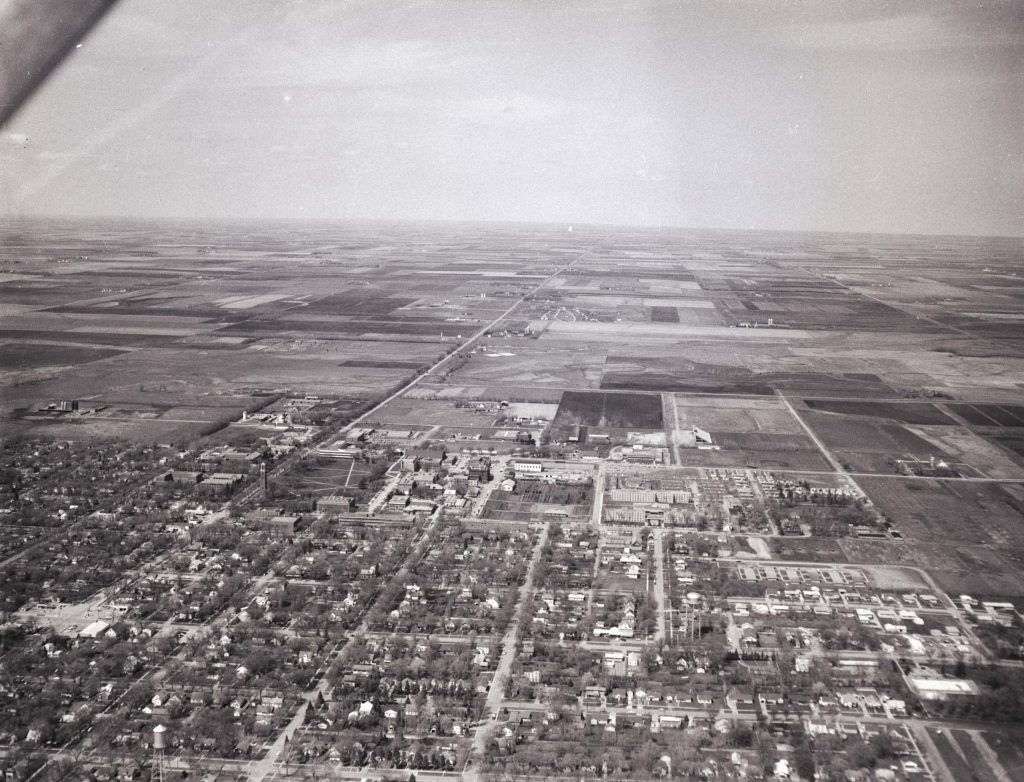
Aerial view of South Dakota State University, 1965. Source: SDSU Special Collections.
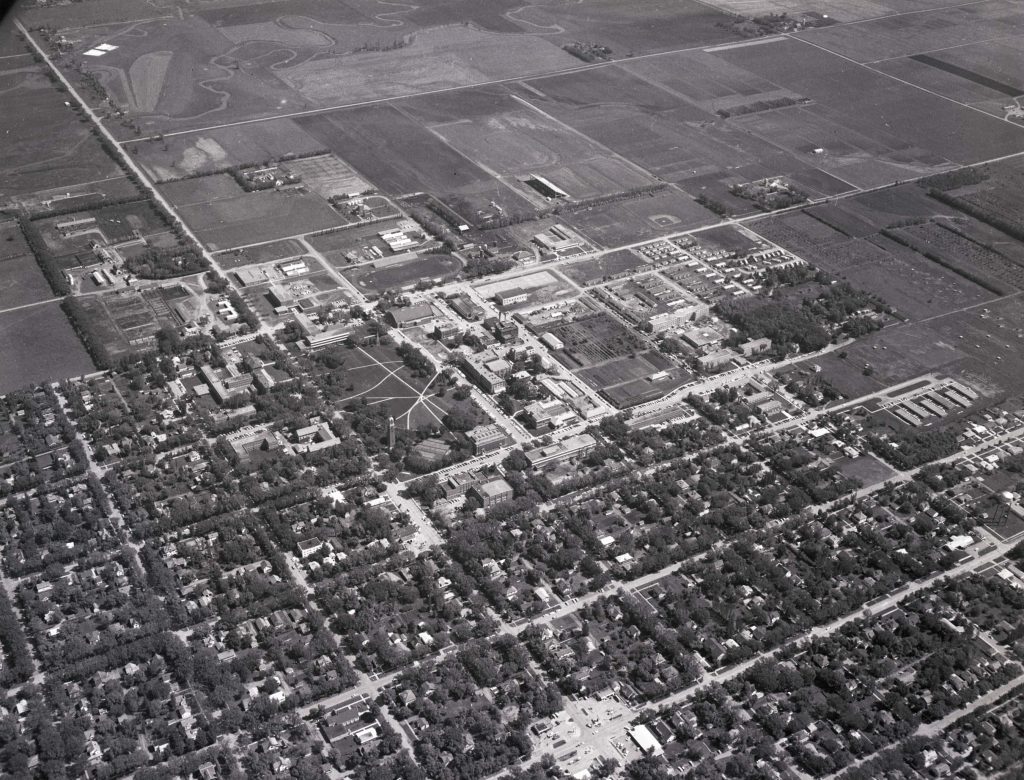
Aerial view of South Dakota State College and Brookings, South Dakota, 1962. Source: SDSU Special Collections.
Brookings High School
Education at Brookings High School was divided in two levels: senior high school (grades 12, 11, and 10) and junior high (grades 9, 8 and 7). For many years the Principal of the senior high school was Mr. Virgil A. Bell (April 20, 1909 – October 3, 1997) while the educational district superintendent was Lester D. Horrigan. When Larry Ray attended BHS, the school was located at 609 4th Street. But, in 1968, it was moved to its present location on 530 Elm Ave.
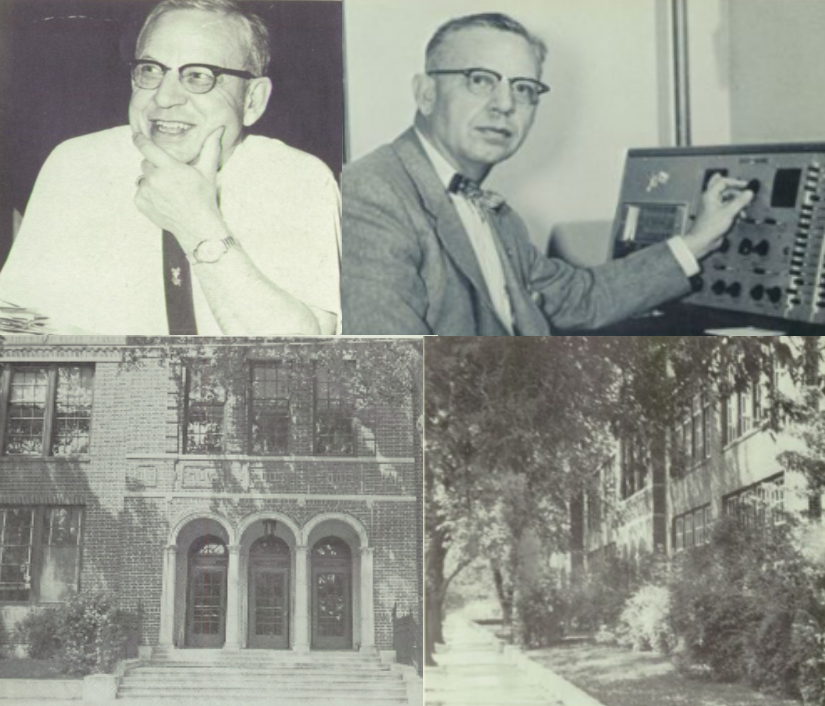
Two sides of Virgil A. Bell and two images of the old Brookings High School building. In 1968, the school moved to a new facility.
The Foreman family moved to Brookings from Hull at the end of August 1957, so thirteen year old Larry Ray Foreman should have entered Brookings Junior High in the 8th grade (this we did not verify it). A year later, he certainly was enrolled in the 9th grade of junior high school.

Left: Nineth-grader Larry Ray Foreman; Right: One year later, Larry Foreman as a sophomore student. Source The Bobcat Yearbook, 1959 & 1960.
At BHS, the young Larry Foreman received his first instruction in science and mathematics from the following teachers: Ruth Helland, who taught Advanced Algebra, Plane Geometry, Solid Geometry and Trigonometry; Robert Stewart, who taught Biology and was the Cross-Country and Track Coach; and Guy Otwell Karnes (1902-1981), who was the Chemistry and Physics teacher and the coordinator of science clubs at BHS like the Kinetics Club and JETS (Junior Engineers Technical Society).
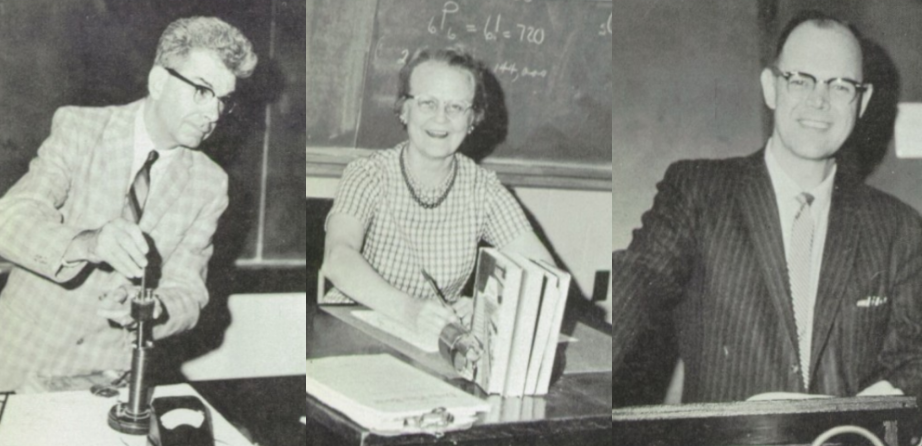
Three BHS science teachers: From left to right, Guy O. Karnes (Chemistry & Physics), Ruth Helland (Mathematics), and Robert Stewart (Biology).
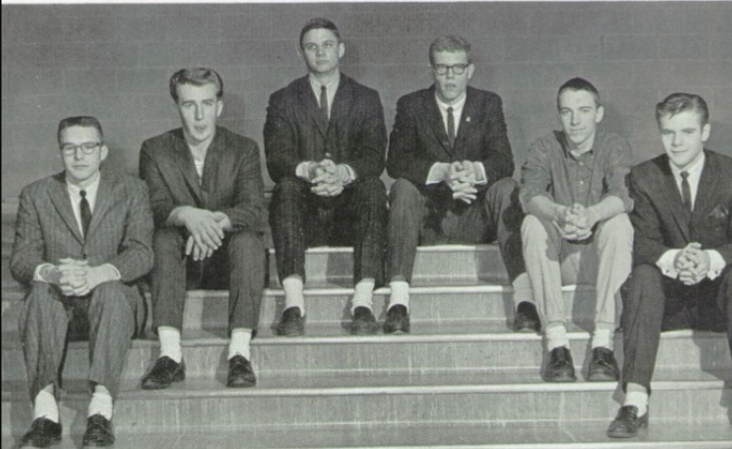
Intramural Basketball Captains, 1962. Under de direction of Coach Gibbons, intramural basketball was for all boys who were not already playing on a school squad. Divided into six teams, each playing the other twice, Foreman’s team walked away with the honors, winning both the league and the tournament championship. The Captains, from left to right, are: Noel Prussman, Ted Kryger, Bruce Stone, Larry Foreman, John Pogue, and Gordon Rezatto. Source:1962 Bobcat Yearbook.
Larry Foreman was a letterman who participated in BHS track team which was then coached by Nig Johnson, Bill Gibbons, and Robert Stewart. BHS participated in many events like debate tournaments, musical performances, and science fairs, and Larry Ray took part in many of these events. He was a member of JETS (Junior Engineers Technical Society) and the Kinetic Club.
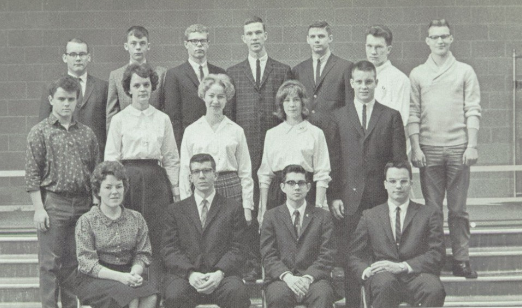
Members of the 1962 Kinetics Club. Front Row: Mary Halo, Leon Jones, Robert Wala, Michael McCann. Second Row: Lynn Puttmann, Irmeli Roine, Ashley George, Martin Johnson. Third Row: Kennon Vaudrey, Alphus Christensen, Larry Foreman, Michael Harrison, Bruce Stone, William Gill, Charles Brownson. Source: Bobcat Yearbook, 1962.
The Kinetic Club was BHS science club. The requirements for membership in the Kinetic Club were a probing interest in science and a willingness to work. Each student member was required to have a project, and to report at the regular meetings on his progress. In 1962, the members of the Kinetic Club participated in the National Science Talent Search, the Regional Science Fair, the National Science Fair, and the South Dakota Jr. Academy of Science (Bobcat Yearbook, 1962).
In June 1961, while was in his junior year, Larry Foreman was among the twenty-five high school students who were named as participants in the six-week National Science Foundation summer training program, which was held at South Dakota State College from June 13 through July 21, 1961. They offered courses in chemistry and mathematics taught by South Dakota State College professors.
We have seen that early in life Larry Ray participated in several singing events, in particular in church related activities. At BHS, he channeled his passion for singing in the school Boys Chorus and the All State Chorus. He was also a Rotarian and a varsity Bobcat staff editor. In 1962, he was the senior editor of the Bobcat Yearbook, 1962.
Because of his excellent academic work and shown leadership skills, he was elected to the National Honor Society. “To be eligible for the National Honor Society, a senior must have a grade point average of 5.25 and a junior an average of 5.5. Membership is also based on leadership, character, and service. Recognition was given its senior members at graduation by the wearing of a gold tassel and a gold chord about the collar of the gown” (The Bobcat, 1962). It thus seems that, at that time, BHS was using a six-point grading system where 6 is Outstanding (High Honor) and 5 is Superior (Honor).
Larry Foreman was also a member of the order of DeMolay. This is a Masonic-like organization (though not affiliated with the Freemasons) founded in Kansas City, Missouri in 1919. It is an international fraternal organization for young men ages 12 to 21 who acknowledge a higher spiritual power. It takes its name from Jacques de Molay, the last Grand Master of the Knights Templar. According to the The Black Hills Weekly (August 29), the 1962 South Dakota conclave of the order met on August 1962 and appointed Larry Foreman as senior steward. Click here, to see more photos of Larry Ray Foreman’s activities in his senior year.

Larry Ray Foreman’s picture in The Bobcat Yearbook, 1962. He, himself, was the editor of the 1962 yearbook. All his many diverse school activities are mentioned.
As you can see from the above description, Larry Ray Foreman was an outstanding high school student and a young man who took part in a dazzling variety of school activities. A number of BHS graduates have become well-known and nationally recognized in their field. For example, Dr. Julie Louise Gerberding (class of 1973) former director of the CDC (U.S. Center for Disease Control and Prevention) and currently Merck’s executive vice president who has just been named 2018 Woman of the Year by the Healthcare Business Women’s Association. But, it seems to us that BHS has never been aware of the achievements of one high school graduate of Class 1962 named Larry Ray Foreman.
Next step in life: Going to college!
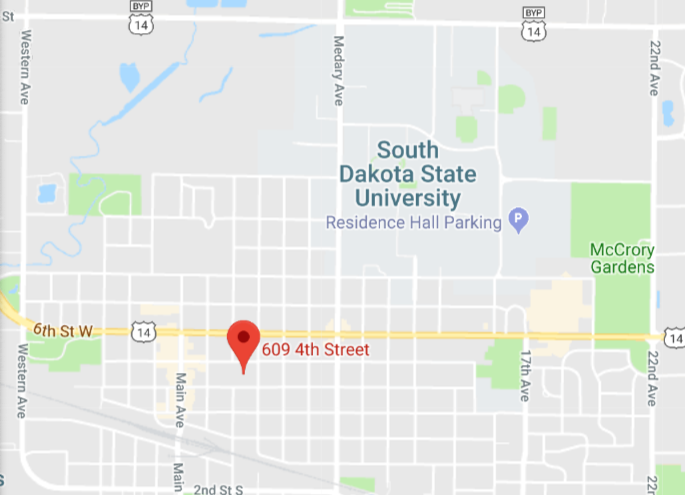
A map showing the location of the old BHS building in relation to the SDSU campus. Source: Google Maps.
Studying Engineering Physics at SDSU
Larry Ray Foreman only had to walk a few yards more to reach college as the two institutions were near each other. South Dakota State University was founded on February 21, 1881, as Dakota Agriculture College. But its name was changed in 1904 to South Dakota State College of Agriculture and Mechanic Arts. This is the name it had when Larry Foreman was a freshman but it was not the name when he graduated in 1966. As, in 1964, the name of the college was changed to South Dakota State University.
When Larry Foreman was attending college, the President of SDSU was the legendary Hilton Marshall Briggs (1913 – 2001) whose administration (1958 – 1975) was marked by high university growth (the enrollment went from about 3,800 to 8,000 students and the campus square footage was largely increased during his tenure).
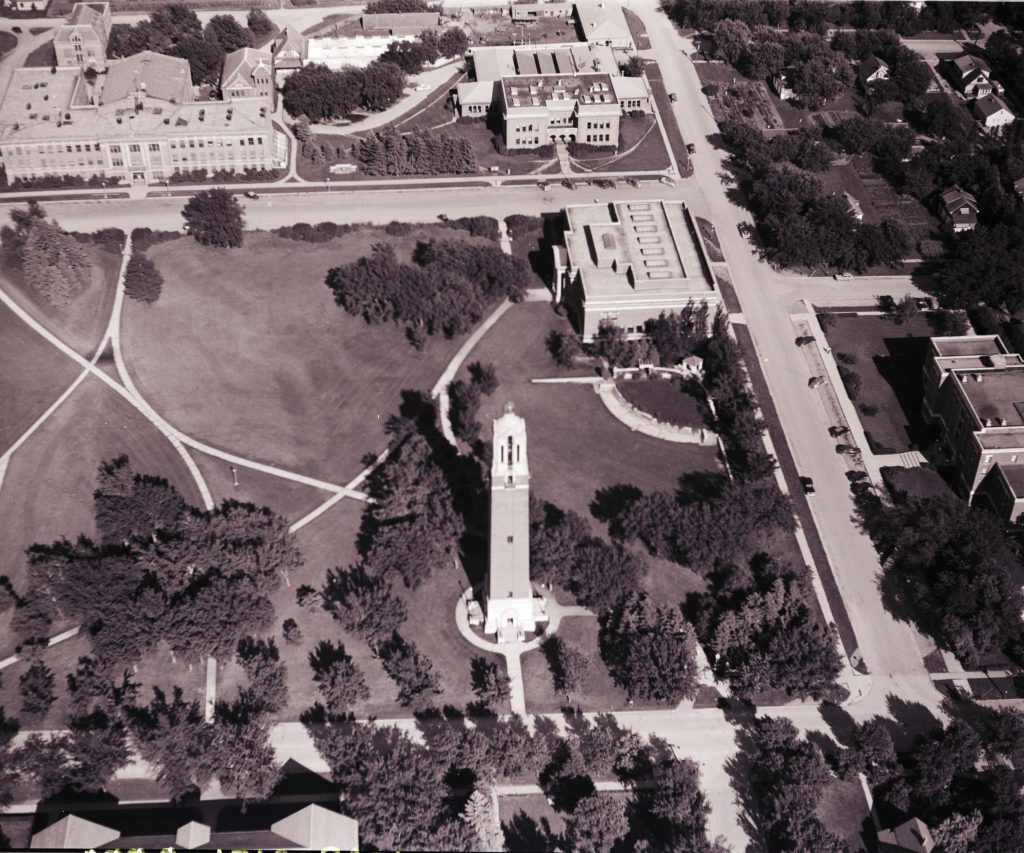
Aerial view of South Dakota State College, 1960, showing the famous Coughlin Companile. Source: SDSU Special Collections.
In the 1960s, the Department of Physics at SDSU was a small academic unit offering majors in Physics and Engineering Physics and a master’s program in both disciplines. Since we could not find a history of SDSU Physics Department, we do not know when the Engineering Physics major was offered for the first time. According to our investigations this major had a long tradition at SDSU as far back as 1944. However, this program seems to have been recently discontinued or cancelled (it is listed in the 2011-2012 catalog but it is not mentioned again in the 2013-2014 catalog and those that follow).
Larry Ray Foreman is not the only SDSU Engineering Physics alumni who achieved success in his professional career. There are a few others SDSU Engineering Physics program grads who have also been successful. Among them are Gene Myron Amdahl (1922-2015), John A. Schmidt (1940-2013), and Leon D. Crossman. Every year, since 1977, the SDSU College of Engineering (today’s Jerome J. Lohr College of Engineering) announces the Distinguished Engineer Award to worthy SDSU engineering alumni, as of today, the Engineering Physics major has produced eight Distinguished Engineers. But, we regret to inform that Larry Ray Foreman was not among them. We think he should have been named Distinguished Engineer but he died before word of his successful career reached Brookings, South Dakota.
Gene Amdahl was the father of the IBM System/360 series series and founder of Amdahl Corporation (B.S. Engineering Physics, 1948; and Ph.D. in Physics from the University of Wisconsin-Madison); John Schmidt, who also worked on fusion physics, was Project Director of the Tokamak Physics Experiment (1992-1995) and Head of Advanced Projects (1996-2005) of the Princeton Plasma Physics Laboratory (B.S. Engineering Physics, 1962; and M.S., 1964; Ph.D., 1969 in Plasma Physics from the University of Wisconsin-Madison); and Leon D. Crossman who, in 1999, retired from Dow Corning was the Vice President and Executive Director of Science and Technology (B.S. Engineering Physics, 1961; and M.S. Engineering Physics, 1964; and Ph.D. in Physics from Iowa State University).
Because we could not rely on a written history of the Physics Department, we had difficulties in finding out who might have been his teachers at SDSU. We are also not clear if the Engineering Physics program was administered by the College of Engineering or by the Physics Department. The catalog has conflicting mentions (the earliest catalog available online is the 1982-1984 catalog, which includes a table on page 39 indicating that the program was administered by the Department of Physics, yet, in the description of the program, it says it is administered by the College of Engineering.)
The curriculum in Engineering Physics, administered in the College of Engineering, is built around a strong core of physics courses supported by allied courses from engineering departments. It is designed to give the ability to apply new research developments to pressing problems of society. Students interested in industrial employment should consider this program. Electives can be chosen to emphasize either electrical or mechanical aspects. Two major areas of employment are applied nuclear physics and solid state. A graduate with this background may enter employment immediately as an Engineer or continue graduate work in physics or another field such as Nuclear Engineering, Electrical Engineering, or Mechanical Engineering.
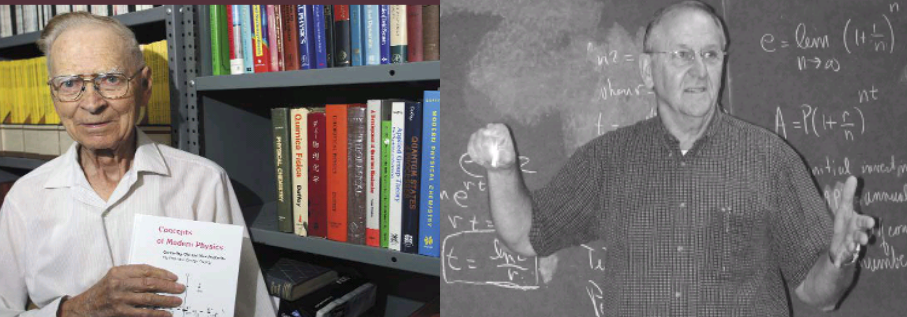
Left: Professor George H. Duffey in 2010 (from Impulse, Spring 2010; then 89 years old and showing his new book. This was the eleventh textbook he has published). Right: Ken L. Yocom in 2004 (from Impulse, Fall 2005). “Every time I write a new textbook, I learn something, too. I’m always curious.” — George Duffey.
At that time (1960’s), our research found out that the General Physics course was taught by professor Perry W. Williams (April 15, 1914 – Nov. 3, 2000), and the Calculus course by professor Ken L. Yocom (b. 1938; retired in April 2005). Other physics professors active then who could have taught Larry Foreman are: George H. Duffey (B.S. Chemistry and Physics, Cornell College, Iowa; Ph.D. in Physical Chemistry, Princeton, 1945), Bruce L. Miller, and Hans G. Graetzer (b.1930). We can safely assume that Larry Ray Foreman took courses from all of them.
The Engineering Physics major included courses in engineering such as Engineering Mechanics, Orientation for Engineers, Engineering Design Graphics, and Metal Processing. Regrettably, we could not find out about which were the Engineering courses he took. And since, at that time, his mother was teaching English at SDSU we are left wondering if she ever taught her son Larry Ray.
The period 1962-1966 was the time when Richard L. Oakland, Dennis Leland Nordstrom, W. Patrick Rahilly, and John A. Schmidt were doing their master thesis in Physics at SDSU. Larry Foreman should have met and had exchanges with them all.
During his studies at SDSU, Larry Ray Foreman did very well academically. On March 1965, he was elected as the president of the Class ’66. His name appeared in the list of Who’s Who among students in American universities and colleges (1966).
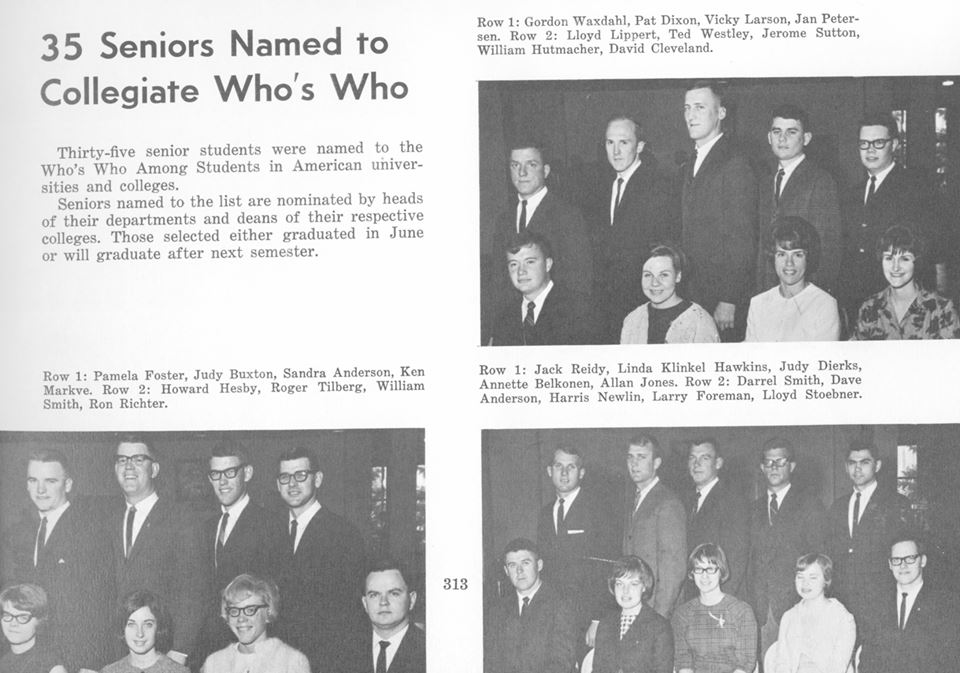
Bottom right picture. Larry Foreman in top row, second person from the right. Source: The Jack Rabbit Yearbook, 1966.
At SDSU, as a freshman, Larry Ray was also involved in the coral movement. In October 1962, the SDSU Music Department – according to The Daily Plainsman – named him a member of the Statesmen.
But while at SDSU, Larry Ray Foreman also enrolled in the Air Force ROTC program. When he was in his junior year, Cadet Liutenant Colonel Larry Foreman was appointed executive officer of the 780th Air Force ROTC Cadet Wing commanded by Cadet Colonel Jerome Sutton (a senior in electrical engineering). In July 1965, for four weeks, he trained at the Lowry Air Force base in Denver, Colorado.
According to The Sioux County Index from Hull, Iowa (May 19,1966):
Larry Foreman, of Brookings, received the Air Force Association Award for leadership and academic accomplishments leading to designation as outstanding senior air cadet. He also was presented the Society of American Military Engineers Gold Medal Award honoring the 20 most outstanding senior engineering students enrolled in ROTC in the nation.
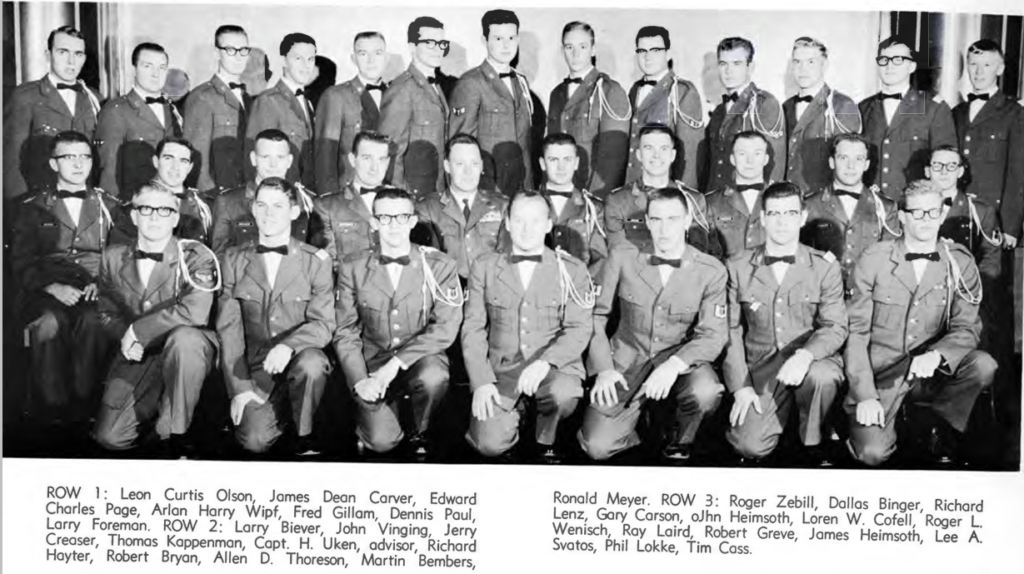
Air Force Drill Team (1964). Larry Foreman is on the first row, first from the right. Source Jack Rabbit Yearbook, 1964
In June 1966, upon graduation, because he was an Advanced Air Force ROTC, Larry Ray Foreman received his commission as Lieutenant in the Air Force. However, shortly afterwards, he was awarded a NASA (National Aeronautics and Space Administration) fellowship, for three years in the amount of $9,000, for graduate study in the field of physics.
According to the Sioux County Capital of October 6th, 1966, he received an educational delay from the Air Force to accept the fellowship. The newspaper also mentions that he planned to enter the Air Force upon completion of his graduate work. But, if he did it, it was for a short time, however, we did not find any evidence of his ever joining the Air Force.
After earning his bachelor’s degree, Larry Ray Foreman attended graduate school at the University of Colorado at Boulder where he obtained an M.S. (1969) and a Ph.D. (1975) in Physics specializing in experimental physics in the field of low temperature physics.
He earned his Ph. D. nine years after his 1966 college graduation. This is an unusual long time. So, it might be quite possible that after finishing his M.S. degree, he did joined the Air Force for a brief period of time (two or three years), returning later to the University of Colorado to earn his Ph. D. But, as it has already been stated, we did not find any evidence of it.
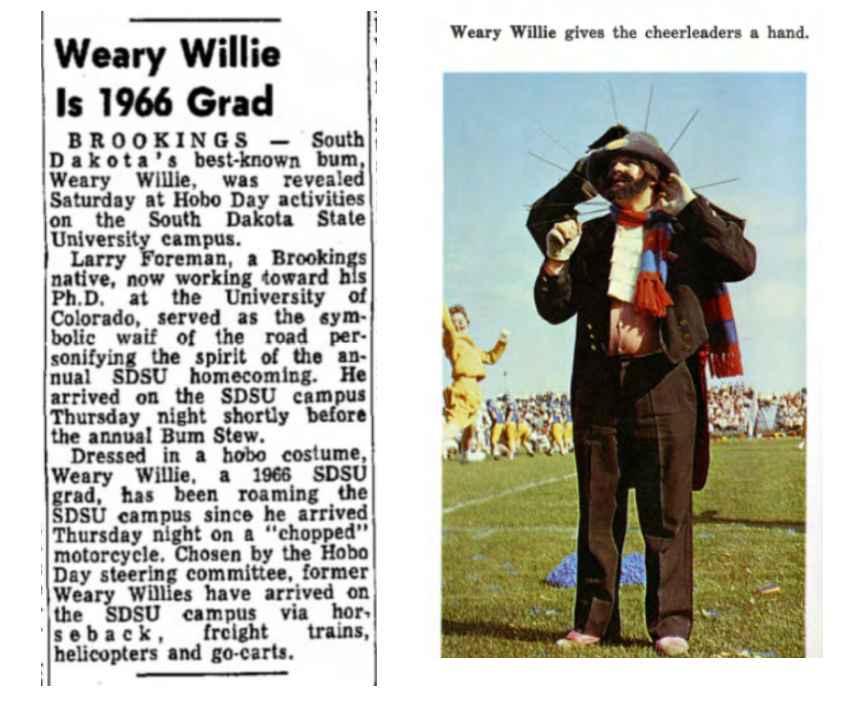
This illustration is a composite made of a clip from The Daily Republic October 17, 1972 (p. 14) and a picture of 1964 Weary Willie taken from Jack Rabbit yearbook for 1964 (the person shown isn’t Larry Foreman; it presented only to convey the idea for readers not familiar with Hobo Day and Weary Willie.)
We can imagine that Larry Foreman had fond feelings for his alma mater. On October 17, 1972, a local newspaper, The Daily Republic, from Mitchell, South Dakota informed its readers that “Dressed in a hobo costume Weary Willie, a 1966 SDSU grad, has been roaming the SDSU campus since he arrived Thursday night on a “chopped” motorcycle.”
This grad was Larry Foreman who had returned to SDSU for Hobo Day, the homecoming celebration for South Dakota State University. Thus, we searched the SDSU digital archive for pictures of Larry Ray Foreman as Weary Willie and we think we found two pictures (SDSU tags for these pictures did not mention his name).
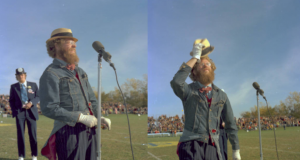
Larry Foreman dressed as Weary Willie for the 1972 Hobo homecoming celebration. These two pictures were taken during the half-time ceremony of the 1972 Hobo Day football game. Source: SDSU Photograph Archives. Hobo Day. PA-02-12-0164 & SDSU PA-02-12-0165 .
Larry Ray Foreman, from the University of Colorado, Boulder to Los Alamos National Laboratory (LANL)
On our Internet searches we did not find any information about his extra-curricular academic activities while he was in Colorado. His doctoral dissertation, approved on February 19, 1975, “Some Investigation in the Growth Decay and Characteristic Size of Vorticity in He II,” was conducted under the direction of Prof. Howard Arthur Snyder (B.S., Engineering Physics, Rensselaer Polytechnic Institute, 1952; M.S., Physics, 1961 and Ph.D., Physics, 1961, both from the University of Chicago).
In turn, Howard Arthur Snyder was the doctoral student of the Canadian-American physicist, known for his work on classical and quantum fluid dynamics, Professor Russell James Donnelly (born April 16, 1930 in Hamilton, Ontario, died June 13, 2015 in Eugene, Oregon). His doctoral thesis was in the field of experimental classical hydrodynamic where he studied the hydrodynamic stability of viscous flow between rotating cylinders with a superposed axial flow. This was a work inspired by a previous theoretical work done at the University of Chicago by the Nobel Prize winner Professor Subrahmanyan Chandrasekhar (1910-1995) (Hydrodynamic and Hydromagnetic Stability, Claredon Press, 1961). His doctoral work was entitled Experiments on the Stability of Spiral Flow at Low Axial Reynolds Numbers.
Prof. Howard Arthur Snyder, born on March 7, 1930, in Palmerton, Pennsylvania, became a specialist in experimental methods in fluid dynamics and cryogenics and in the design of very precise instruments. He began his career as Assistant Professor and, later as Associate Professor of Physics, at Brown University, Providence, 1961-1968. Then, he moved to Colorado where he went from Associate Professor to Professor of Aerospace Engineering Sciences at the University Colorado, Boulder, since 1968. He retired from the University of Colorado in 1999. After retirement, he became Professor Emeritus. He died on May 28th, 2015, in Boulder, Colorado.
Larry Ray Foreman choice of a doctoral advisor in the Aerospace Engineering Sciences Department could be also related to the support he had previously received from NASA. This is just a guess as we were not able to discover any evidence for it.
Some results related to Larry Ray’s doctoral research topic were later communicated at the 1978 American Physical Society (APS) general meeting conference (see the title of his paper under the heading Conference Proceedings and LANL Reports in the section The Physics of Larry Foreman).
His first publication in a peer review journal appeared, in 1979, four and a half years after his Ph.D thesis (Foreman, Larry R., and Snyder, Howard A. “The penetration of superfluid turbulence through porous filters.” Journal of Low Temperature Physics 34, no. 5 (1979): 529-538.)
Immediately after obtaining his doctoral degree in 1975, Larry Ray Foreman traveled to San Cristóbal, Táchira, Venezuela where, from February 1975 to approximately March 1977, he worked for the then newly created Universidad Nacional Experimental del Táchira (UNET) (more about his stay in Venezuela later). After leaving Venezuela, he returned to the University of Colorado, Boulder where he worked for the Department of Mechanical Enginnering (he was there on August 1978).
The application of VES Project’s DHS methodology did not produce any digital fragments about Larry Ray Foreman for the period April 1977 to July 1978. By March 1979, he had moved to the Department of Chemical Engineering and Material Sciences at the University of Minnesota, Minneapolis. However, our VES Project research could not determine for how long he remained at the University of Minnesota.
Next, in the advancement of his career, Larry Ray Foreman joined Los Alamos National Laboratory (LANL). Even though LANL refused to provide information on the date when he joined LANL (Alan Carr, LANL’s historian: “Unfortunately, I am not authorized to release information on current or former employees. Per current Laboratory policy, I am only permitted to confirm that Dr. Foreman did indeed work here”), we have reasons to believe that he joined LANL in 1981. At LANL, Larry Foreman worked for the Materials Science and Technology Division and, at some point in his professional career, he began to lead LANL’s efforts in target fabrication for inertial confinement fusion.
His earliest publication on a peer reviewed journal showing an affiliation with LANL is from March 28, 1988 which, by the way, seems to be his second peer review publication (nine years after his first paper of 1979).
DHS did not produce any digital fragments about Larry Ray Foreman for the period April 1979 to September 1987. This investigation, however, found copies of some old slides (transparencies or viewgraphs) from his presentation at the JOWOG 28 session held in Los Alamos, October 6-8, 1987 (JOWOG stands for Joint Working Groups; these were a series of numbered meetings established by the Anglo-American nuclear cooperation whose bases were set by the 1958 Mutual Defense Agreement (MDA) between UK and USA. JOWOG 28 meetings are dedicated to problems in Non-Nuclear Materials).
For an experimental physicist, Larry Ray Foreman published few research papers in peer reviewed journals. Even though an exhaustive search was not carried out, our regular DHS investigation only found 17 papers, one book chapter, 10 reports or communications to conferences and five patents (for details, see the list of papers in the section The Physics of Larry Foreman).
The reasons for this reduced number of publications is related to his shorter life span (of 55 years) and, mainly, to the fact that for the better and longer part of his professional career, Larry Ray Foreman worked in the field of fusion science and technology at LANL and most of his research work could have been deemed classified material by the U. S. Department of Energy.
That some of his research work might have been classified can be gathered from an editorial that Larry Foreman wrote for the proceedings of the Tenth Target Fabrication Specialists’ Meeting (TFSM) held in Taos, New Mexico, on February 6-10, 1995. An excerpt of his editorial is presented below.
Larry R. Foreman’s Editorial
Larry Ray Foreman became an expert on target fabrication for Inertial Confinement Fusion. Because one of the Fusion Technology journal issues for 1995 (Volume 28, No. 5) was dedicated to target fabrication, he was invited as guest editor for this particular issue.
There, Larry Foreman wrote (pp. 1771-1772) (emphasis added)
In 1981, Charles Hendricks, then head of the inertial confinement fusion (ICF) fabrication activities at Lawrence Livermore National Laboratory (LLNL), recognized the need to initiate collaboration on the processes and materials issues related to fabricating targets for laser and light ion ICF. Hendricks organized the First Target Fabrication Specialists’ Meeting (TFSM), which was held in Denver, Colorado, in the summer of that year. This initial meeting was successful; the participants agreed that it was an excellent, relatively informal forum for exchanging essential information on target fabrication. The series has continued on an ~18-month schedule to the present time, hosted alternately by LLNL and Los Alamos National Laboratory (LANL). Because much of the work on ICF was classified during this time period, the meetings have always had a large classified component.
The Tenth TFSM was held in Taos, New Mexico, and was hosted by LANL. Like its predecessors, this meeting was quite successful, continuing the tradition of providing an excellent forum for information on target fabrication. Unlike its predecessors, this meeting was completely unclassified, thanks to new classification guidance on ICF from the U.S. Department of Energy (DOE). For the first time, the meeting could open its doors to target fabricators from France, Japan, and Russia. Because of the open discussions and the decidedly international flavor, the Tenth TFSM was particularly exciting. Representatives attended from the United States, the United Kingdom, Japan, France, Russia, and Canada.
Larry Ray Foreman was co-recipient of the 1999 Edward Teller Medal for his contributions to the development of inertial fusion science due to his innovative work in target fabrication. He had previously been recognized by Los Alamos National Laboratory with the Distinguished Performance Award. We think that the name Larry Ray Foreman should be remembered along side other American physicists of Dutch ancestry like James Van Allen (1914–2006), astronomer for whom the Van Allen belt is named; Robert J. Van de Graaff (1901–1967), the physicist who developed the Van de Graaff generator; Nicolaas Bloembergen (1920-2017), who received the 1981 Nobel Prize in Physics for his contributions to the development of the driving principles behind nonlinear optics for laser spectroscopy; and Samuel Abraham Goudsmit (1902–1978) and George Eugene Uhlenbeck (1900 – 1988), who are both famous for having introduced the concept of the electron spin.
Larry Ray Foreman in San Cristóbal, Venezuela
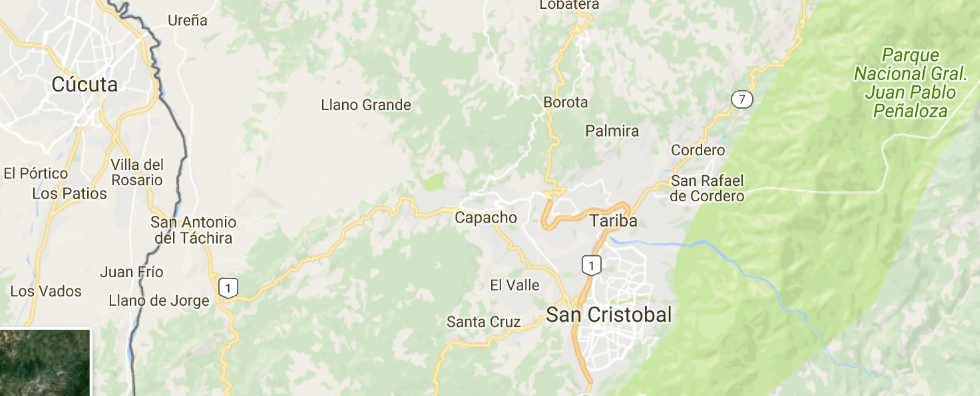
Regional map showing the cities of San Cristóbal (Venezuela), San Antonio del Táchira (Venezuela) and Cúcuta (Colombia). Source: Google Maps.
In Venezuela, before 1958, the main mission of Physics departments were to teach physics courses as a service for engineering students. There was very little physics research being done in the country. As a research discipline, Physics only got started when the Faculty of Science at Central University of Venezuela (UCV) was created in March 1958. At that time, nearly one hundred percent of the physics professors were foreign born.
But, by 1975, Physics as a research activity in Venezuela could be pursued at five institutions: one research institute (the Instituto Venezolano de Investigaciones Científicas (IVIC) near Caracas (1958)) and four universities (two located in the Caracas metropolitan area: UCV (1958) and Universidad Simón Bolívar (USB) (1974), one in eastern Venezuela at Universidad de Oriente (UDO) (ca 1967) where, in part, Physics got started with the support from the University of Kansas and the KUUDO plan, and another in western Venezuela, in the State of Mérida, at Universidad de Los Andes (ULA) (1967)); between parenthesis, the year when physics research got started.
At this time, about 60 to 70 percent of all physics professors were foreign immigrants (this is a personal judgement as this writer began to study physics at UCV in 1974). The largest job market for physicists was in the Caracas metropolitan area and new local physics graduates were not quite willing to go to the provincial cities to live and work. Throughout the period of 1960 to about 1980, overall salaries for university faculty in Venezuela were competitive with United States universities (for example, in 1961, at UCV, the monthly salary for a full professor was $1,062, $621 for an assistant professor and $577 for an instructor. At the University of Columbia, in New York, the same positions were paid less $1,042, $583 and $458, respectively. In 1974, the monthly salary for an instructor at Venezuelan public universities was 3,500 Bs. or, at the then exchange rate of 1$=4.30 Bs., the equivalent of US $814).
Táchira is a state in western Venezuela Andean region (it shares its northeastern border with the State of Mérida). By 1970, this state did not have any public college level education. After high school, except for a small outpost in Táchira from the Caracas based private Catholic University (UCAB), the student population of this state had to attend college in Caracas, Mérida, at Universidad del Zulia, in the nearby city of Maracaibo, Zulia State, or even at universities in neighboring country of Colombia. But all this was going to change soon.
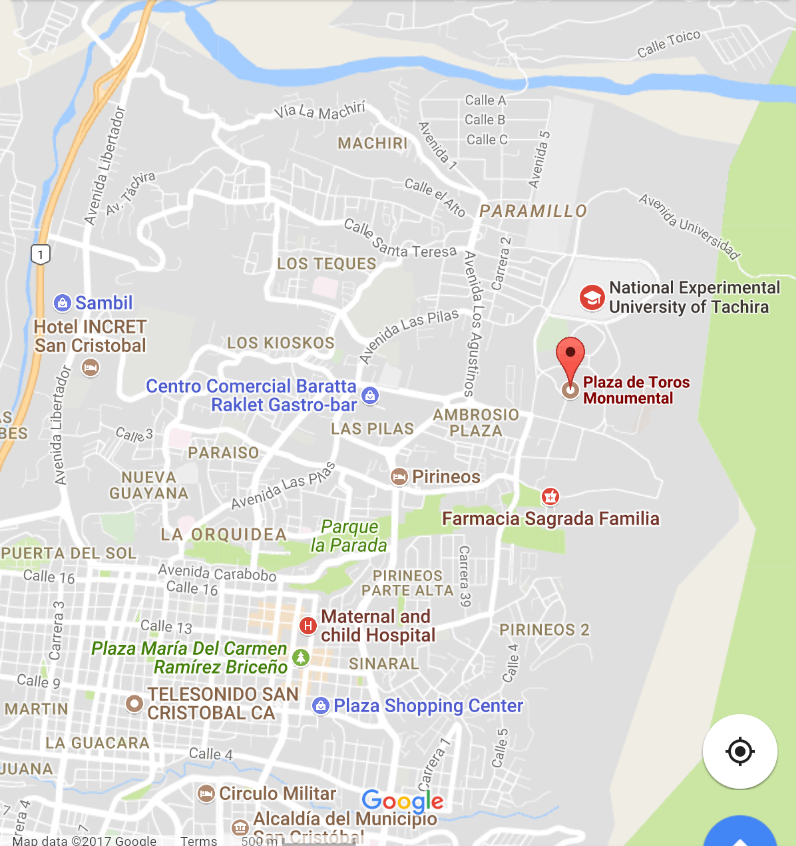
Map showing the location of the National Experimental University of Táchira (UNET) in the northeast part of San Cristóbal. The Avenue “19 de Abril” mentioned in this article is not labeled on the map. This avenue is located south of Calle 4 toward bottom-middle section of the map. Source: Google Maps.
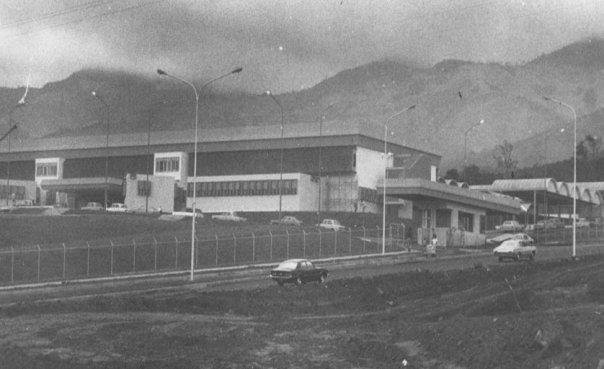
UNET main building (1975). Facilities att the new campus in Paramillo, northeast San Cristóbal, on 45 hectares (111.2 acres) from the former Hacienda Paramillo. Source: UNET.
On February of 1974, in the city of San Cristóbal (founded in 1561), the capital of the State of Táchira, the Venezuelan central government created (by Decree No 1630, February 27, 1974), the Universidad Nacional Experimental del Táchira (UNET; in English, National Experimental University of Táchira) which, initially began teaching courses leading to only four degrees: two in agricultural sciences (agricultural engineering and zootechnic (i.e. animal production)) and two in engineering (industrial and mechanical engineering).
The final planning and organization stages were carried out from the Nigal Building (Edificio Nigal) on San Cristóbal ‘s Avenue “19 de Abril”. By April 1975, the administrative team and the recently hired faculty had already moved to the new facilities, northeast of San Cristóbal, on 45 hectares (111.2 acres) that used to be part of the Hacienda Paramillo (Paramillo Farm, in English).
Classes at UNET began on June 23rd, 1975. But some months earlier, on August 1974, the university was facing a problem: how to staff UNET Physics Department. On hindsight, the solution was reached as follows.
The first president or rector of UNET was Lorenzo Monrroy Coronel (1923-1998). He was an educator who had graduated from the Instituto Pedagógico Nacional (IPN) in 1946 with a specialization in social sciences (IPN is a high school teacher training college). Some years after his graduation, he traveled to the U.S. to study. At the University of Wisconsin, he earned a Master of Education in Educational Administration. Prior to UNET, he had served as the Director of Secondary Education at the Venezuelan Ministry of Education and had also been involved in developing plans for the creation of two universities (UDO and USB). On June 23rd, 1975, he delivered the first lecture at UNET through the university closed-circuit television system (called, in Spanish, Sistema Integrado de Educación Dirigida) to a student body of about 600 incoming students. At that time, the UNET faculty was less than 50 professors.
Throughout his long term career as an educator, Lorenzo Monrroy developed a deep friendship with Benjamín Mendoza Sánchez (1921-1984), who had also graduated from IPN (majoring in Literature) and, likewise, had served as Director of Secondary Education as well. By 1969, Benjamín Mendoza had already returned to Venezuela from a two-years work assignment (1965-1967) in London, England, and was serving as the coordinator of Simón Bolívar University (USB) where Monrroy had also served as an advisor.
With high school physics teacher, photographer and social activist, Sara “Sarita” Guardia Blanco (1923-1995), Benjamín Mendoza had three children. One of them is the physicist Dr. Claudio Mendoza Guardia (BSc, 1973; Ph. D., 1980; both degrees from University College London (UCL)). Today, Claudio Mendoza is a researcher in Theoretical Atomic Physics and Astrophysics (and the winner of the 1978 UCL Carey Foster Research Prize). But, in 1965, being only fourteen years of age, he had traveled to England with his parents. However, when they returned to Venezuela, he was left behind to finish off his high school education at William Ellis School, Highgate, London and to pursue a B. Sc. degree in Physics at UCL. By 1974, Claudio Mendoza had already returned to Venezuela and he was somehow nudged into going to San Cristóbal to join UNET’s planning efforts to create the Physics Department.
In September 1974, knowing English well, but having only a bachelor’s degree in Physics and lacking teaching experience, twenty-three-year-old Claudio Mendoza was the best available person Rector Lorenzo Monrroy could hire to staff the Physics Department. As the only department member at that time, we can say that Claudio Mendoza, working from an office in “Edificio Nigal”, was UNET Physics Department.
Out from an office at the Nigal building, all by himself, but being coached by Rector Lorenzo Monrroy, Claudio Mendoza began the procurement tasks to buy from foreign suppliers all the equipment needed to furnish and set up the required physics teaching laboratories. He also started the recruitment efforts to get more experienced physics teachers. Therefore, it was Claudio Mendoza the person who contacted and invited Larry Foreman to come to Venezuela and helped him find housing, on 19 de Abril Avenue, in San Cristóbal.
Larry Foreman’s Ph.D. thesis approval date is February 19th, 1975. In the same month (February 15th, 1975), Larry Foreman appeared listed as the head of the UNET Physics Department. He had six months to prepare for the first day of class on June 23rd, 1975.
For a few months, Claudio Mendoza and Larry Foreman worked together to set up the physics laboratories and design the Physics programs for incoming engineering and agroscience freshmen. But Claudio Mendoza did not stay long at UNET. By the end of 1975, he was already back in London pursuing his Ph. D. under the supervision of Professor Michael John Seaton (1923 – 2007).
Political instability in Chile also helped to solve the staffing needs. In 1973, Chilean President Salvador Allende (1908-1973) fell from power. Opposing the new regime, many Chilean scientists and engineers had to flee Chile and emigrate to other countries. Many chose to come to Venezuela, among them was Electronic Engineer Pablo Moragas, who, on March 1977, took over as head of the Physics Department when Larry Foreman left the position to return to the United States.
Moragas did not serve long as a head of the department. He was replaced by another member of the Physics Department, Rafael Serrano Sarmiento (1944-2012), a Colombian Material Engineer who was a graduate from Rensselaer Polytechnic Institute (BSc, 1968; MS, 1970). He had also joined UNET in 1975. He was the chairman of UNET Physics Department from October 1st, 1977 to December 16, 1980.
His own family
When Larry Ray Foreman came to Venezuela, he did not come alone. So, here is the right place in our narrative to talk about his own family.
Gordon E. Medlock (1923-2017) was a Business Administration major who graduated from Northwestern University in 1946. On September 15, 1944 (the same year when Larry Ray was born) he married Barbara Puls (1924-2014). Together, they had four children: Gordon Jr. (1946), Trudi (May 1, 1948), Christine (1950-2014), and Charles P. “Chuck” (1958).
Larry Ray Foreman married Trudi Medlock, a Biology major from Northwestern University (B. Sc., 1970), born in or near Milwaukee, Wisconsin (from 1947 to 1953, her mother Barbara lived in White Fish Bay, Wisconsin as her husband, Gordon E. Medlock, worked as a sales manager for Stearns Magnetic Manufacturing in Milwaukee).
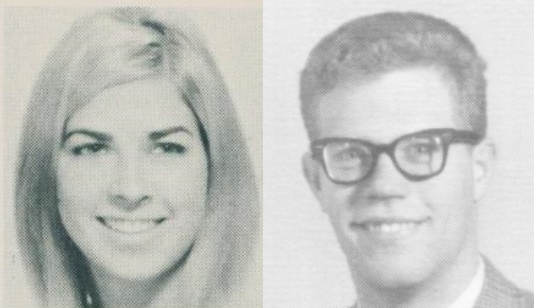
Trudi Medlock in 1968 and Larry Ray Foreman in 1966. Source: Northwestern University and South Dakota State University catalogs.
Larry Ray and Trudi had two sons: Gabe Benjamin Foreman (1974) and Alexis Stuart Foreman (1976). Larry Ray came to Venezuela with his wife Trudi, his son Gabe Benjamin, and his sister-in-law Christine. For a couple of years, the city of San Cristóbal became an outpost for the Foreman-Medlock family. Here in Venezuela, Trudi became pregnant with Alexis. Today, there are people in San Cristóbal who still remember a beautiful, three-to-four-months pregnant American woman jogging along the “19 de Abril” Avenue in San Cristóbal (at that time, San Cristóbal was a somewhat traditional and old-fashioned city in the Venezuelan Andes, a pregnant woman jogging must have been a quite unusual and peculiar sight, making it difficult to forget).
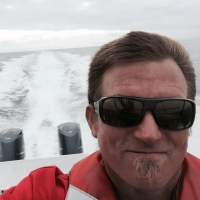
Gabe Foreman. Source: SCOPE
Gabe Benjamin obtained a B.Sc. degree in Physics (1997) from the University of California, San Diego and presently works as a Marine Research Engineer for the Simons Collaboration on Ocean Processes and Ecology (SCOPE) at the University of Hawaii. Alexis Foreman earned a B.Sc. in Physical Chemistry (2000) from Montana State University, Bozeman and pursued graduate studies in Mechanical Engineering at the University of Colorado, Boulder.
Together with Jeffrey Alder, Alexis Foreman cofounded Wild Goose Canning, in Boulder, Colorado where he is now the company’s president.
As to Trudi Medlock Foreman, she married Jeffrey Alder and her Linkedin account shows she is working as a Science Operations Manager at SomaLogic, Inc. in Denver, Colorado. However, her LinkedIn account does not seem to be updated, as we found digital traces of her presently working for a molecular diagnostics company in Boulder, Colorado called Biodesix. A company that provides blood-based diagnostics to patients with lung disease. She also appears featured on recent (April 20, 2018) Kaiut Yoga video.
It also seems that Trudi M. Foreman joined LANL (in October 1983, at the Chemical Science and Technology Division, CST-18) where she worked on problems related to the contamination of beryllium in the environment, how to minimize discharges of uranium reprocessing, the biodegradation of paint stripper solvents, and, among others topics, the integrated chemical and biological treatment of waste mixed with a paintstripper. We could not figured out for how long she stayed at LANL (she was still there in 2003). Unfortunately, we could not cross-check the information presented in this paragraph.
Trudi’s sister, Christine, was a very energetic person, a lifelong sportswoman, who earned her B.A. and M.S. at the University of Colorado in Boulder. She also worked in Venezuela as a university professor at UNET teaching English as Foreign Language for two years. In 1979, she married Tom Daggett and had three children Matt Daggett (married to Cara Leigh New), James Daggett (married to Neely Zangenehzadeh), and Lauren Daggett. Back in the US, Christine taught English as a Second Language, Spanish, and Etymology at Oak Park and River Forest High School, Oak Park, Illinois for 13 years and, later, she joined the University of Denver as an adjunct faculty. She died of cervical cancer on March 27, 2014.
As to Larry Foreman, he had a long struggle with colon cancer. He passed away on Oct. 12, 1999 as his professional work was becoming known and he was beginning to be recognized for it. As physicists can be highly productive into their eighties. At 55, Larry Ray Foreman died too young and too soon.
Guessing Larry Ray Foreman’s reasons for coming to Venezuela
Now, we must pose the question of why a newly minted Ph. D. in Physics, specialized in low temperature physics, would decide to travel to a provincial Venezuelan city to teach physics forestalling his research career as a physicist (as there were no immediate plans at UNET to start research in Physics. At that time, the only place in Venezuela where low temperature research was being carried out was at IVIC’s Low Temperature Laboratory which began its research activities in January 1965).
Why he didn’t stay in the U.S. where doing research in Physics was and is much easier and feasible since there is a long tradition in scientific research, the infrastructure needed to make science is highly developed and, generally, there are good funding sources?
Of course, this investigation did not have access as to what Larry Ray Foreman could have been thinking in 1975 when he decided to come to Venezuela. However, a review of the history of science in the U.S. can provide us with clues to a plausible answer.
Well, it turns out that in the early seventies the labor market for physicists crashed for two main reasons: the 1969’s landing on the Moon and the escalation of American involvement in the Vietnam war. In 1966, the budget of the National Aeronautics and Space Administration (NASA) was 4.46% of the U.S. federal government’s budget. When the U.S. won the space race, which we must remember was an important aspect of the Cold War, there was no urgency to continue financing the space research program. Simultaneously, in the early seventies, because of the Vietnam war, the budget of the U.S. Department of Defense increased highly (in 1961, there were 2,000 American soldiers stationed in Vietnam, and by December 1965 this figure had increased to 200,000). New jobs in Physics depended on federally funded research. But, as a result of these two trends, there was a sharp decline in federally funded research (for example, by 1970, NASA’s budget was 1.92% of the U.S. federal government’s budget, and for 1971, it was 1.61%).
Moreover, to young Ph. D. holders seeking academic positions in Physics, it did not help at all that during the late 1960s and early 1970’s there was an oversupply of new Physics Ph.D.’s as American universities continued to produce Physics Ph.D.’s with an annual growth rate of 8 percent to a record high of 1,545 new Ph.D.’s in 1970-1971. In fact, 1970 is considered as a catastrophic year for the employment of physicists in the U.S. (see, Job shortage hits older physicists hardest).
There is yet another reason. Because there were fewer job positions available and there was an overabundance of physicists in the market, real wages of physicists declined. In a study of labor market conditions for Ph. D. graduates, Freeman and Breneman (1974) observed that between 1964 and 1969 the actual annual salary of physicists with Ph. D. increased by 14.7 per cent, but between 1969 and 1973 the real salary of physicists with Ph. D. fell by 23.1 per cent.
Finally, we must remember that at that time, Venezuela’s university professors salaries were highly competitive with overseas salaries. As a result, a country like Venezuela benefited from reversed brain drain. In 1971, in the United States, the unemployment rate of new physicists with Ph. D. was 4%. This percentage was not higher because 14% of physicists with Ph. D. went abroad seeking employment and many managed to secure it. Among them, in Venezuela, to name but a few, there were physicists Larry Ray Foreman, Cuban-American theoretical physicist Robert Berezdivin (Ph. D. from the University of California, Berkeley), Amar Singh, Loren Lockwood, and Richard Eckert (all three of them got their Ph. D. degrees in Physics from the University of Kansas.)
We have seen Larry Ray Foreman graduate from high school at Brookings High School and from college at South Dakota State University, earn a doctorate degree at the University of Colorado-Boulder, teach at universities in Venezuela and the United States before starting a career as a research scientist at Los Alamos National Laboratory where he took an active part in the development of one important aspect of fusion science: target fabrication.
But, what are the specifics of his contributions to fusion science. Follow us to discover it!
CLICK HERE TO GO TO PART II CONTINUES.
LARRY RAY FOREMAN, AN AMERICAN PHYSICIST OF DUTCH ANCESTRY. THE PHYSICS OF LARRY FOREMAN
Support for VES Project
VES Project is a Venezuelan independent research initiative with no other source of funding except for the support it receives from its readers and people sympathetic toward the project’s aims and objectives. Because living conditions in Venezuela has become very difficult and harsh, your support is now more needed than ever to help us continue doing more research and writing.
VES Project needs funding to continue researching and writing the life stories of the Venezuelan STEM migration. If you wish to support VES Project, you can use PayPal to make a donation by clicking the DONATE button below. Your help will be highly appreciated. Thanks !
ABOUT THE AUTHOR:
José G. Álvarez Cornett (Twiter: @Chegoyo)
Member of COENER, and the “Physics and Mathematics for Biomedical Consortium“. Teacher of History of Physics and Cultural History of Science at the School of Physics, Faculty of Science, Central University of Venezuela and Alumni Representative before the School of Physics Council.
@Chegoyo 2018.



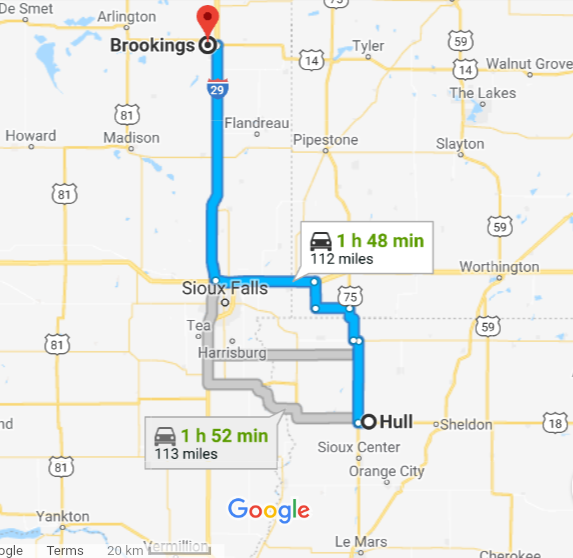
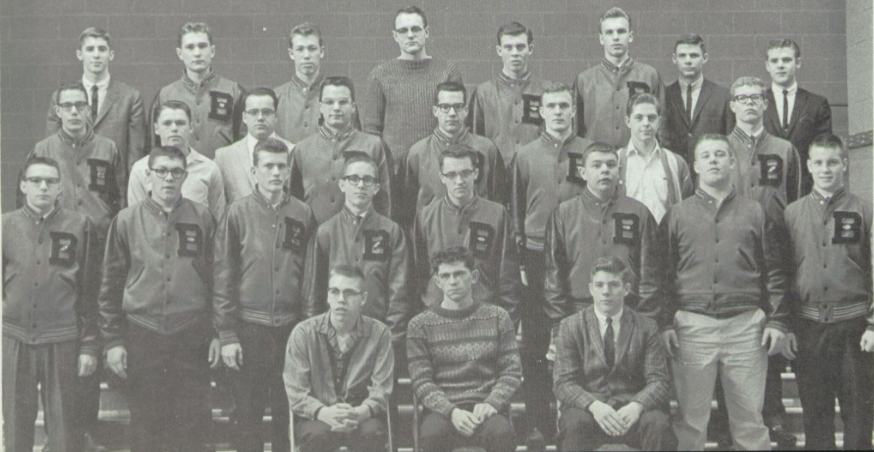
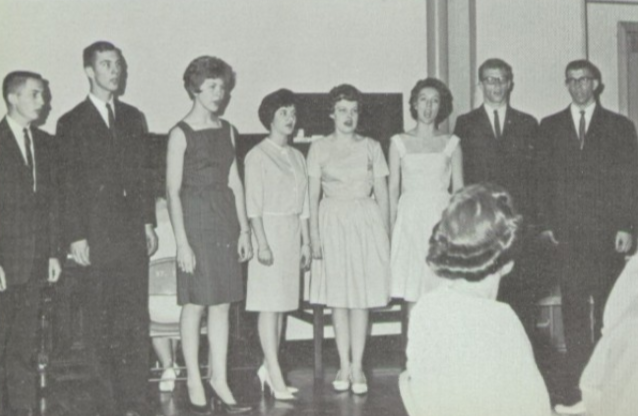
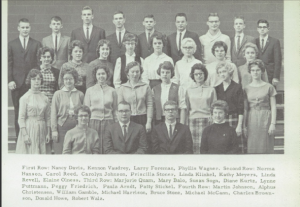
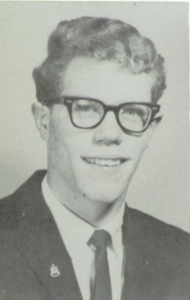
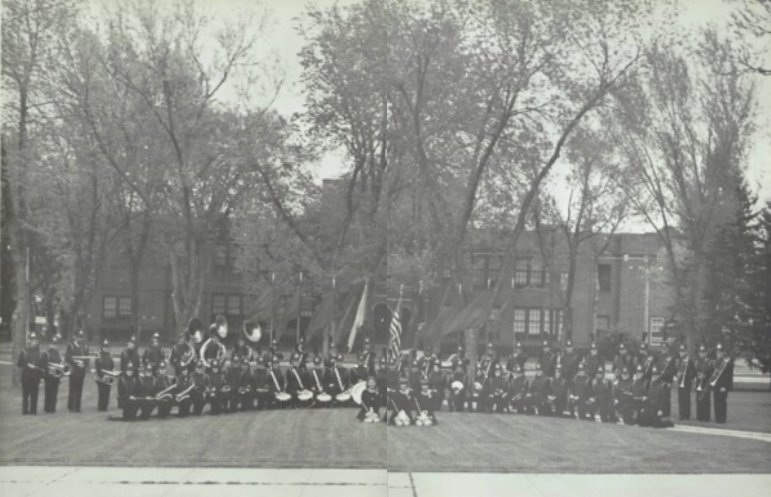
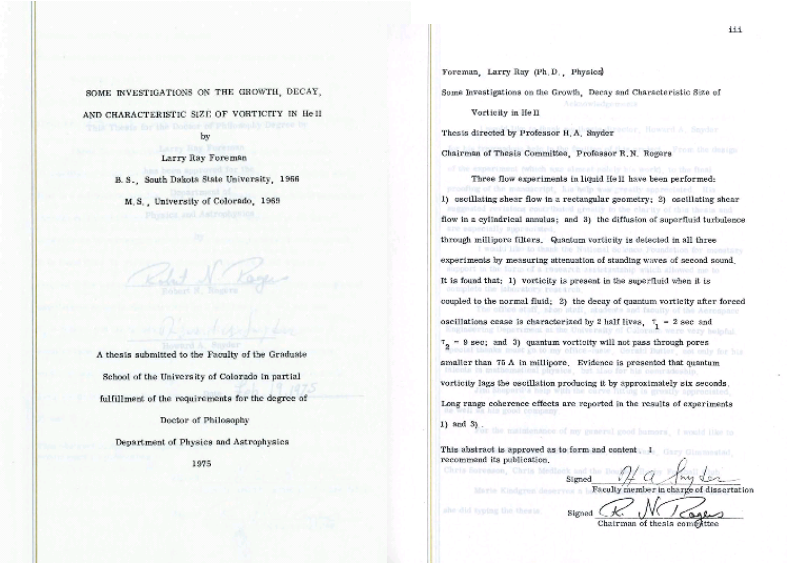

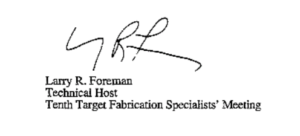
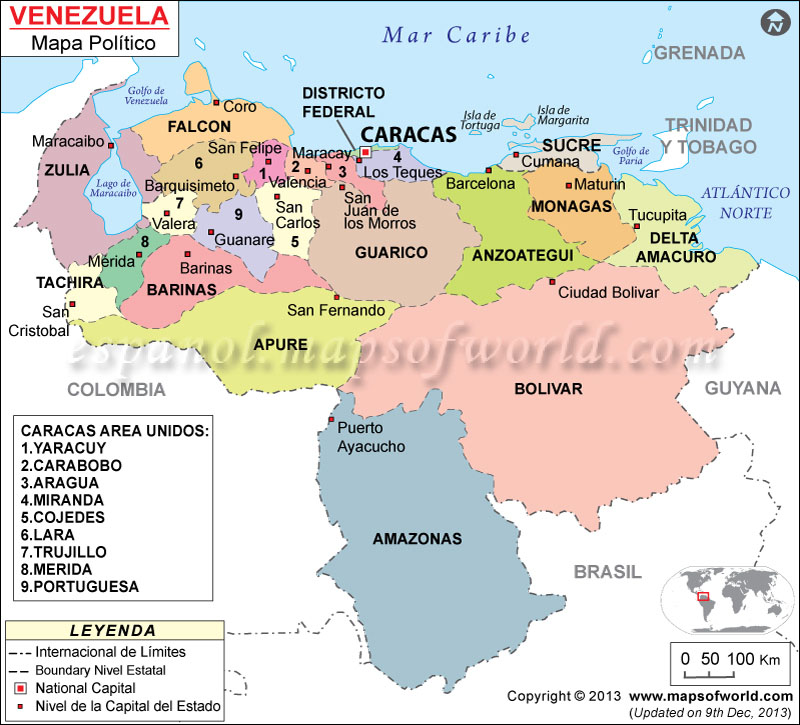
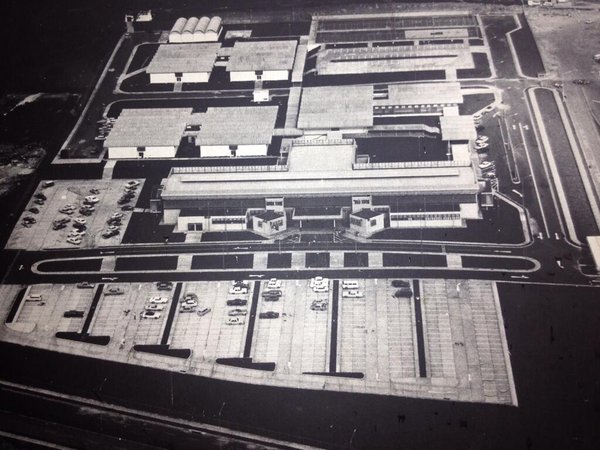
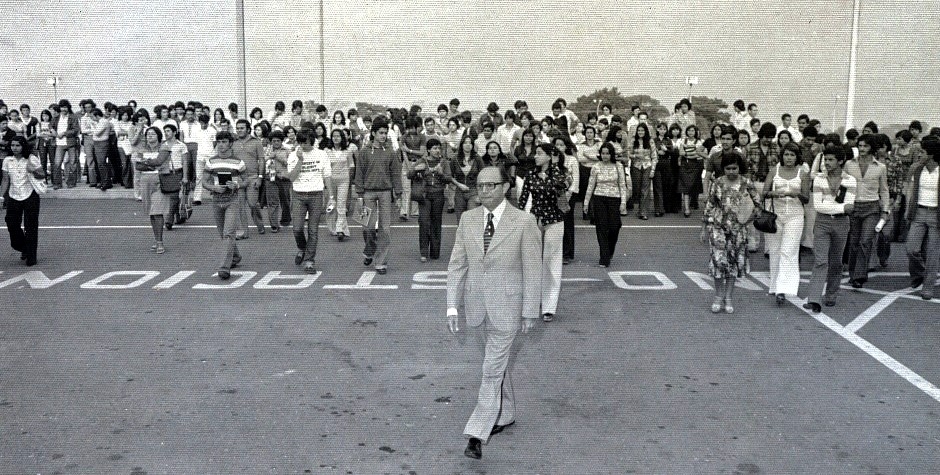
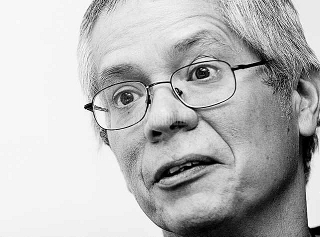
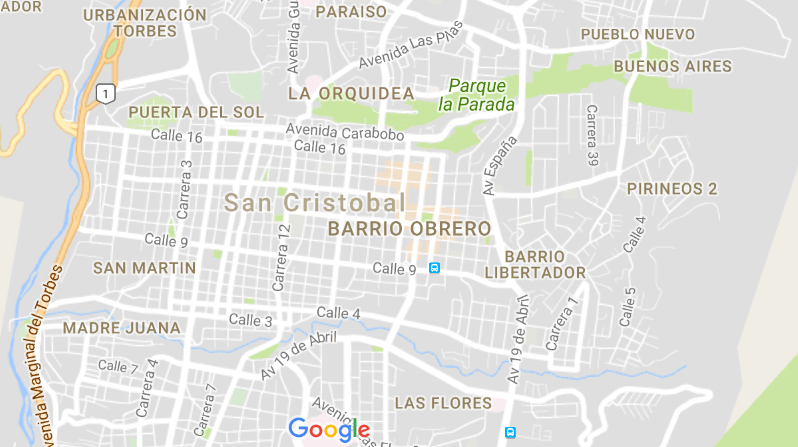
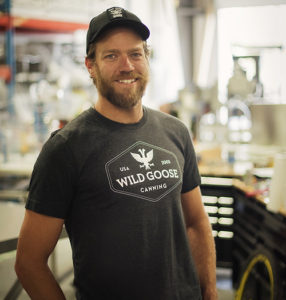
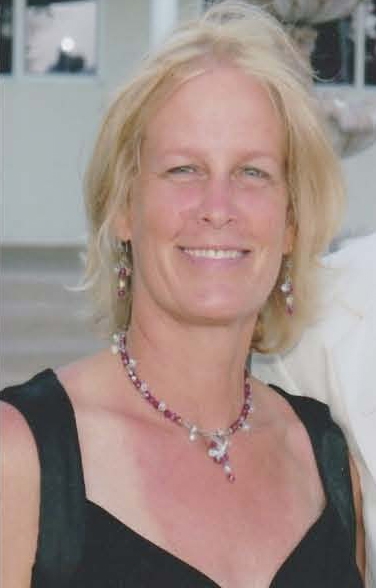
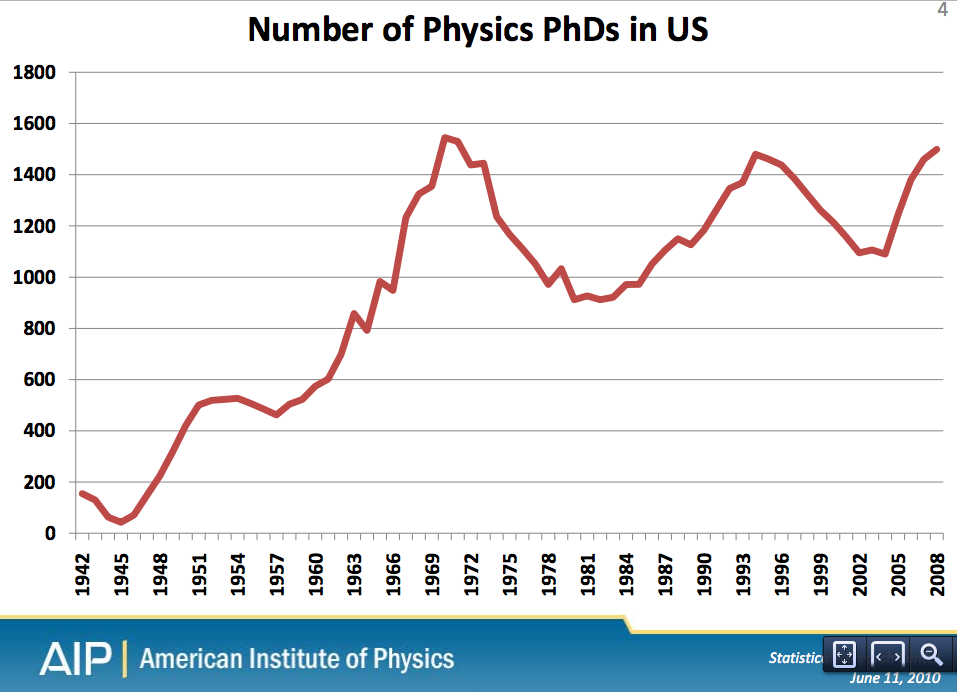

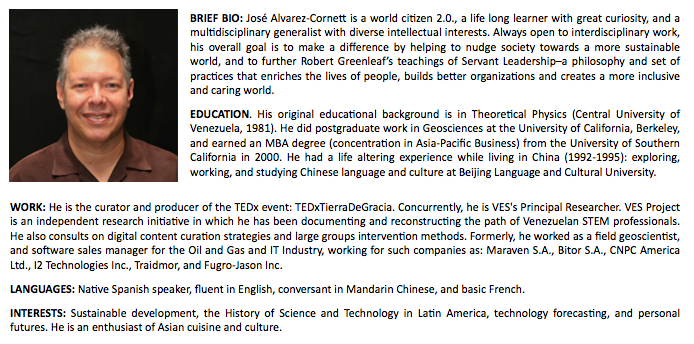
Recent Comments